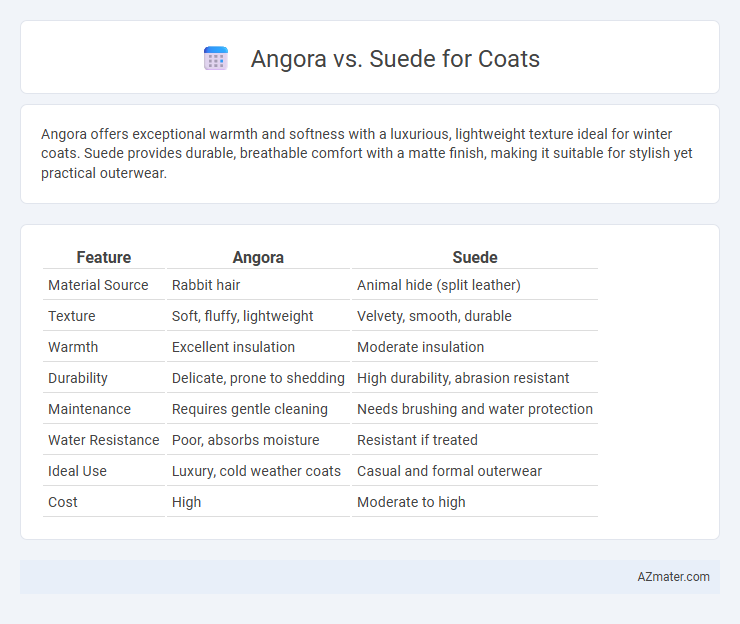Angora offers exceptional warmth and softness with a luxurious, lightweight texture ideal for winter coats. Suede provides durable, breathable comfort with a matte finish, making it suitable for stylish yet practical outerwear.
Table of Comparison
| Feature | Angora | Suede |
|---|---|---|
| Material Source | Rabbit hair | Animal hide (split leather) |
| Texture | Soft, fluffy, lightweight | Velvety, smooth, durable |
| Warmth | Excellent insulation | Moderate insulation |
| Durability | Delicate, prone to shedding | High durability, abrasion resistant |
| Maintenance | Requires gentle cleaning | Needs brushing and water protection |
| Water Resistance | Poor, absorbs moisture | Resistant if treated |
| Ideal Use | Luxury, cold weather coats | Casual and formal outerwear |
| Cost | High | Moderate to high |
Introduction to Angora and Suede Coats
Angora coats are crafted from the soft, luxurious fibers of Angora rabbits, known for exceptional warmth and a lightweight feel, making them ideal for cold-weather fashion. Suede coats feature a smooth, velvety texture derived from the underside of animal hides, offering durability and a stylish, matte finish perfect for casual and formal wear. Both materials provide unique insulation properties but differ significantly in maintenance and aesthetic appeal, influencing their selection for seasonal outerwear.
Material Origins: Angora vs Suede
Angora originates from the Angora rabbit, known for its luxurious, lightweight, and exceptionally soft fiber, prized in high-end winter coats for superior warmth and comfort. Suede is derived from the underside of animal hides, primarily lamb or goat, offering a velvety texture and durability ideal for stylish, casual outerwear. The natural origins of Angora provide insulating properties, while Suede delivers resilience and a distinctive matte finish, influencing their use in coat fabrication.
Texture and Appearance Comparison
Angora coats feature a soft, fluffy texture with a natural sheen, offering a luxurious, lightweight feel that provides warmth without bulk. Suede coats exhibit a smooth, matte finish with a velvety surface, delivering a more structured and durable appearance while retaining softness. The plush, airy quality of Angora contrasts with Suede's dense, textured look, influencing the overall style and tactile experience of each fabric.
Warmth and Insulation Properties
Angora coats provide superior warmth and insulation due to their natural fine fibers, which trap heat effectively and offer exceptional softness against the skin. Suede, while stylish and durable, lacks the same insulating properties because it is made from the underside of animal hides, which is less effective at retaining heat. For cold weather, angora is a preferred choice for maintaining body warmth, whereas suede coats often require additional layers to achieve comparable insulation.
Durability and Longevity
Angora coats, made from the soft, fine fibers of Angora rabbits, offer exceptional warmth but require delicate care due to their tendency to shed and pill, impacting durability over time. Suede, derived from the inner split of animal hides, is more resistant to wear and more durable in daily use, though it demands regular maintenance to prevent water damage and stains. For longevity, suede coats typically outperform Angora by maintaining structural integrity with proper treatment and being less prone to fiber degradation.
Maintenance and Care Differences
Angora coats require gentle hand washing or dry cleaning to maintain fiber softness and prevent shedding, with careful storage away from direct sunlight to avoid yellowing. Suede coats demand regular brushing with a suede brush to remove dirt and prevent matting, alongside applying water and stain repellents to protect the nap and maintain texture integrity. Both materials benefit from proper ventilation and spot cleaning, but Angora's delicate nature necessitates more cautious handling compared to the more durable, maintenance-friendly suede surface.
Ethical and Sustainability Considerations
Angora wool raises significant ethical concerns due to animal welfare issues, as angora rabbits are often subjected to painful hair harvesting practices, whereas suede, typically made from animal hides, involves the use of leather that contributes to environmental degradation and high carbon emissions. Sustainable alternatives include plant-based or synthetic suede and cruelty-free angora blends, which minimize harm to animals and reduce ecological impact. Choosing coats made from responsibly sourced, certified materials or recycled fibers supports ethical fashion and promotes greater sustainability in the apparel industry.
Style and Fashion Versatility
Angora coats offer a luxurious, soft texture with a natural sheen that elevates winter fashion, creating a sophisticated and elegant look ideal for upscale events. Suede coats provide a smooth, matte finish with a casual yet refined appeal, versatile enough for everyday wear and layering across seasons. Both materials enhance style versatility, with Angora emphasizing warmth and glamour, while Suede suits a more rugged, effortlessly chic aesthetic.
Price Range and Investment Value
Angora coats typically carry a higher price range due to the rarity and softness of angora wool, often costing between $300 and $1,000 or more. Suede coats are generally more affordable, with prices ranging from $150 to $600, depending on the quality and brand. Angora represents a stronger investment value for luxury and insulation, while suede offers durability and style at a moderate cost.
Choosing the Right Coat: Angora or Suede?
Angora coats offer exceptional warmth and softness due to their high-quality wool derived from Angora rabbits, making them ideal for cold climates and luxury fashion. Suede coats provide a stylish, supple texture with moderate insulation, perfect for mild weather and casual elegance. Choosing between Angora and Suede depends on your climate needs and desired aesthetic, with Angora suited for insulation and luxury, while Suede offers comfort and versatility in transitional seasons.

Infographic: Angora vs Suede for Coat
 azmater.com
azmater.com